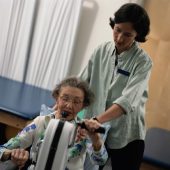Balance in Old Age Tied to Brain Changes
Monitoring white matter levels may assist early identification of walking problems.
|
E-mail this article
Subscribe to news
Printer friendly version
|

(SOURCE: American Academy of Neurology, news release, March 17, 2008)
TUESDAY, March 18 (HealthDay News) -- The severity of age-related changes to white matter in the brain affects how well older people are able to move around and keep their balance, a new study says.
White matter changes -- called leukoaraiosis -- are common in older people.
The study participants included 639 women and men, ages 65 to 84, who underwent walking and balance tests, along with brains scans. The scans revealed that 284 of the volunteers had mild age-related changes to their brain's white matter, 197 had moderate changes, and 158 had severe changes.
Compared to those with mild changes, people with severe changes were twice as likely to score poorly on the walking and balance tests and twice as likely to have a history of falls. Participants with moderate changes were 1.5 times more likely than those with mild changes to have a history of falls.
The findings of the three-year study were published in the March 18 issue of the journal Neurology.
"Walking difficulties and falls are major symptoms of people with white matter changes and a significant cause of illness and death in the elderly," study author Dr. Hansjoerg Baezner, of the University of Heidelberg in Mannheim, Germany, said in a prepared statement.
"Exercise may have the potential to reduce the risk of these problems, since exercise is associated with improved walking and balance. We'll be testing whether exercise has such as protective effect in our long-term study of this group," said Baezner, who noted that mobility problems in older people often lead to hospitalization and nursing-home placement.
Monitoring white matter changes may assist early identification of walking problems, which have been linked to other health issues.
"Recently, gait abnormalities have been shown to predict non-Alzheimer's disease dementia, so recognition, early diagnosis and treatment of this disabling condition may be possible through early detection of walking and balance problems," Baezner said.
The causes of white matter changes and the reasons why it's worse in some people aren't fully understood. However, researchers have found evidence of a link to insufficiently treated high blood pressure.
More information
The AGS Foundation for Health in Aging has more about walking problems. 
Copyright © 2008 ScoutNews, LLC. All rights reserved. 
HealthDayNews articles are derived from various sources and do not reflect federal policy. healthfinder.gov does not endorse opinions, products, or services that may appear in news stories. For more information on health topics in the news, visit the healthfinder.gov health library.